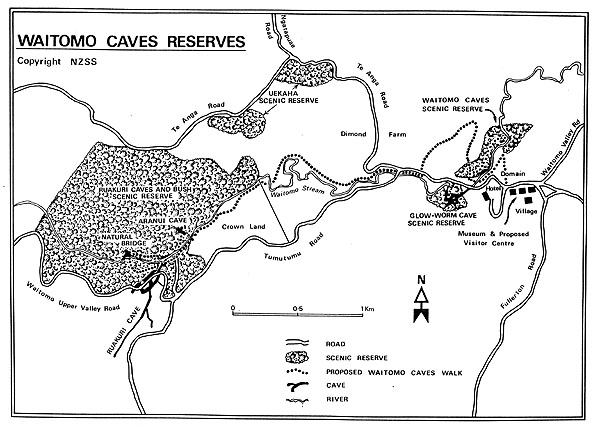A PROPOSAL FOR A WAITOMO CAVES WALK
The New Zealand Walkways Act 1975 provides the opportunity to establish " ... walking tracks over public and private land so that the people of New Zealand shall have safe, unimpeded foot access to the countryside for the benefit of physical recreation as well as for the enjoyment of the outdoor environment and the natural and pastoral beauty and historical and cultural qualities of the areas they pass through."
The Act is administered by the New Zealand Walkways Commission which co-ordinates a number of committees throughout the country. Recently a proposal was submitted to the South Auckland Walkways Committee for their consideration.
The distinctive landforms of the Waitomo Caves village and environs provide the opportunity to develop a public walkway focussing on a 'karst experience'. The most favourable route for such a walkway would commence at the village and link the following areas:
- Waitomo Caves Domain (administered by the Waitomo District Council).
- Waitomo Caves Scenic Reserve includes the Waitomo Glowworm Cave (administered by the Tourist Hotel Corporation).
- The Dimond farm (owned by P and S Dimond).
- Crown Land leased to P Dimond (administered by the Commissioner of Crown Lands, Hamilton).
- Ruakuri Caves and Bush Scenic Reserve - includes the Ruakuri and Aranui tourist caves (administered by the Tourist Hotel Corporation).
The proposed walkway would be approximately 4.5km in length and would traverse a distinctive karst landscape located amongst farmland and forest, and comprising karren outcrops, dolines, caves, gorges, sinking and rising streams, and an impressive natural limestone bridge (or arch).
Apart from linking three nationally significant tourist caves and associated facilities, the proposed walkway would provide a high grade walking track through the forest of the Ruakuri Caves and Bush Scenic Reserve to the Ruakuri Natural Bridge.
The Ruakuri Natural Bridge is a striking limestone arch approximately 160m long and 25-30m high; and is apparently the remnant of a large cave. The Waitomo Stream passes through the arch and exits over a series of waterfalls through a small gorge. High 'windows' formed from remnant cave passages provide visitors with spectacular views of this scenically outstanding feature.
Consideration is being given to developing a suspended boardwalk through the arch itself, but this must be weighed against possible visual and environmental impacts (a small colony of long-tailed bats is known to roost beneath the arch). It would however, provide the touring public with an experience normally only available in remote areas such as Karamea.
On-site interpretation, and written guides would describe the botanical, wildlife, historic and cultural values along the walk, and would focus on the processes of the karstification of the local landscape.
Interpretation of the karst environment around Waitomo would expand the tourist cave visitor experience to include an awareness of karst ecosystems, and the relationship between surface and subterranean processes, thus providing the opportunity for a more complete and meaningful visit to the area. Recreational opportunities would also be improved as a result of the proposed walkway.
Tourism in New Zealand is known to be increasing and a continued rise is projected for the immediate future. In line with these predictions the Tourist Hotel Corporation is considering developing Ruakuri Cave for more intensive tourist use (D Evans and D Williams pers comm).
Conclusions:
- The development of a high grade walking track as described above would provide a 'karst experience' for visitors to Waitomo.
- The proposed walkway promotes the objective of the General Policy for Cave and Karst Management by engendering an awareness of the scientific, scenic and recreation significance of karst and cave resources through the interpretation of cave and karst features to the general public at a location appropriate for this purpose.
- The proposed walkway will provide a valuable walking link between the three Waitomo tourist caves and associated facilities, and the Waitomo Village and environs.
- It would also provide visitors with the opportunity to utilise the time between cave tours, particularly in respect of Ruakuri Cave and possible future development.
The proposed walkway will provide high grade walking access to features of significant scenic value for the purpose of recreation, education and tourism.

Figure 1: Waitomo Caves Reserves
References
Lands and Survey (1984) New Zealand Walkway Commission -1984 Policy Statement. Department of Lands and Survey, Wellington.
Lands and Survey (1985) General Policy for Cave and Karst and New Zealand Management in Areas Managed by the Forest Service, Department of Lands and Survey and the New Zealand Forest Service. Department of Lands and Survey, Wellington.
Wilde, K A (1985) Walkway - South Auckland Land District. Proposed Waitomo Caves Walk. Department of Lands and Survey, Hamilton (File 312851/1).
Personal Communications
D Evans, Secretary, Tourist Hotel Corporation.
D Williams, Caves Manager Waitomo, Tourist Hotel Corporation